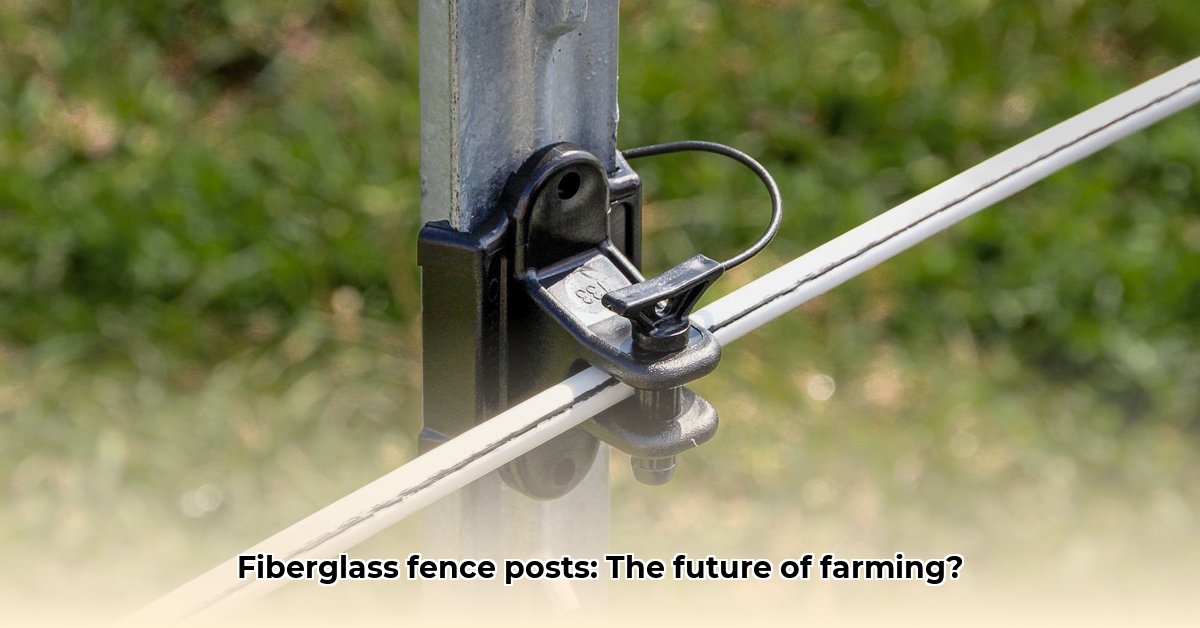
The Long Haul: Durability and Longevity
Replacing fence posts is a costly and time-consuming chore. Traditional wood rots and requires frequent replacement, while metal corrodes, weakening over time. Fiberglass fence posts from Tractor Supply Co. offer a game-changing solution. Their exceptional durability significantly reduces the need for frequent replacements, minimizing waste and maximizing your long-term investment. Many fiberglass posts come with warranties guaranteeing their longevity for decades, representing impressive cost savings compared to short-lived alternatives. This extended lifespan is a cornerstone of their sustainability, reducing the continuous cycle of manufacturing, transport, and disposal associated with traditional materials. Do you want to spend less time replacing fences and more time tending your crops? Fiberglass posts present a compelling case. For more information on fiberglass posts, check out these options.
Eco-Friendly Fencing: Minimizing Your Environmental Footprint
Sustainable farming necessitates environmentally conscious choices. Fiberglass fence posts contribute to this philosophy in several key ways. Many manufacturers incorporate recycled materials into their production, reducing reliance on virgin resources and lowering your farm's carbon footprint. Though fiberglass production involves energy consumption, the remarkably long lifespan more than offsets the initial energy investment. This compares favorably to the continuous cycle of production and disposal required for wood and metal posts. Choosing posts from companies with a proven commitment to responsible sourcing and manufacturing further reduces the environmental impact. Is minimizing your carbon footprint a priority? Fiberglass posts offer a practical and effective solution.
Beyond the Fence Line: Versatile Applications in Sustainable Farming
The utility of fiberglass fence posts extends far beyond basic livestock containment. Their strength and durability make them ideal for diverse sustainable farming practices:
Rotational Grazing: Electric fencing systems utilizing fiberglass posts enable efficient livestock grazing management. This rotational approach improves pasture health, preventing overgrazing and promoting regrowth, leading to healthier animals and more productive land. Improved pasture health contributes to increased grazing efficiency and reduced environmental impact.
Crop Trellising: Fiberglass posts provide strong and durable support for climbing crops, minimizing ground contact, thereby reducing pest and disease issues and ultimately improving yields. The strength of fiberglass allows for taller and more robust trellising systems, maximizing crop production.
Riparian Buffer Zones: Fiberglass posts are ideal for constructing effective barriers along waterways. Their resistance to rot makes them perfect for protecting sensitive riparian areas from erosion and agricultural runoff, preserving water quality and biodiversity. Protecting water resources is vital for sustainable and responsible farming.
The Numbers Matter: Cost-Benefit Analysis
While the initial cost of fiberglass posts may appear higher than traditional materials, a true cost-benefit analysis reveals remarkable long-term savings. Reduced labor costs associated with fewer replacements, minimized waste destined for landfills, and the extended lifespan contribute to a significantly lower overall cost per year of service. Improved efficiency and increased productivity gains from optimized grazing management and enhanced crop support further strengthen the financial case for fiberglass posts. It’s crucial to perform a comprehensive cost analysis; consider your current maintenance and replacement costs and the long-term economic benefits of fiberglass posts will become apparent.
Installation: A Step-by-Step Guide
Installing fiberglass fence posts is a straightforward process:
Planning and Site Preparation: Carefully plan post placement to ensure efficient fencing that meets your specific needs. Assess terrain and soil conditions.
Hole Excavation: Use a post-hole digger to create appropriately sized holes. Depth and diameter are crucial for fence stability. Ensure adequate drainage around each post.
Post Setting: Carefully set posts in holes, ensuring they are plumb (vertically straight). Firmly tamp soil around the base for stability.
Backfilling and Compaction: Use a backfill material, such as gravel, to enhance stability and drainage. Compact the backfill thoroughly to prevent shifting and settling.
Wire/Netting Attachment: Securely attach fencing wire or netting using appropriate fasteners. Follow manufacturer instructions for optimal results.
Ongoing Care and Responsible Disposal
Fiberglass posts require minimal maintenance. Regular inspection for damage is recommended. At the end of their lifespan, inquire about recycling options with local waste management authorities or the manufacturer. While fiberglass recycling infrastructure is developing, responsible disposal practices are paramount.
Weighing the Pros and Cons
While fiberglass posts offer numerous advantages, it's important to acknowledge potential drawbacks:
| Pros | Cons |
|---|---|
| Exceptional durability and longevity | Higher initial cost compared to wood or metal posts |
| Extremely low maintenance | Can be brittle; strong impacts might cause breakage |
| Resistant to rot, decay, and insect damage | May require specialized tools for installation in some cases |
| Environmentally friendly manufacturing options | Recycling infrastructure still under development |
In Conclusion:
Fiberglass fence posts from Tractor Supply Co. offer a compelling solution for environmentally conscious farmers seeking durable, long-lasting, and cost-effective fencing. The initial investment is balanced by significant long-term savings, reduced environmental impact, and increased operational efficiency. This investment enhances the sustainability of your farm and contributes to a more responsible approach to agricultural practices.